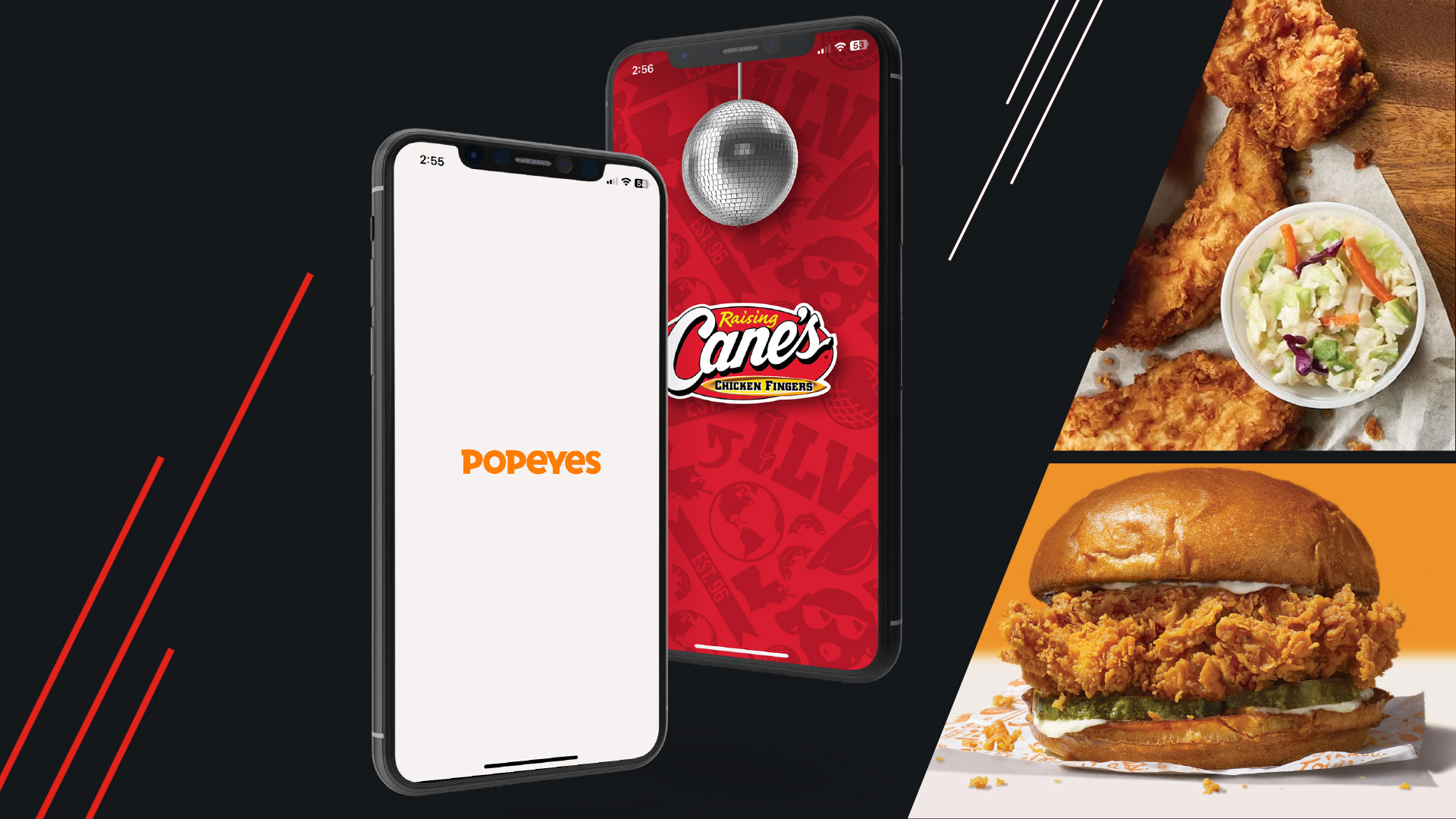Published by
Welcome to The App Faceoff, a series in which we perform a digital experience review across two apps in the same industry to explore how they stack up in areas such as design, customer engagement and growth.
At Bottle Rocket, we specialize in building and growing digital experiences for leading brands in a variety of industries. Each of the analysis points for this App Faceoff are measurable areas that should be considered when evolving and growing a digital experience, such as a mobile app, website, or kiosk. To enhance our analysis with even deeper insights, we’ve also partnered with Enterpret, an industry leading customer feedback analytics platform that helps product teams integrate the Voice of the Customer into their product development process to build impactful products. Read the full App Faceoff here!
App Popularity and User Base
Both apps have high ratings with 100k+ reviews. We can tell based upon the iOS ranking and the number of Android installs that Popeyes has a much larger user base, which is to be expected considering Popeyes has 2,700 locations in North America compared Raising Cane’s which has roughly 700.

Tech Spotlight
The Raising Cane’s app is built with Capacitor on top of Ionic, while the Popeyes app uses React Native with Expo. Though different, both of these are cross-platform technologies, enabling them to deliver nearly identical experiences across both iOS and Android platforms while using a single codebase.
See page 3 for a full deep dive into the tech.
Acquisition Campaigns
%20(2).png)
Popeyes employs a comprehensive strategy to acquire new users for their mobile app, leveraging various channels to drive downloads and engagement. Most digital campaigns focus on product promotions, showcasing exclusive deals and discounts only available through the app, creating a strong incentive for customers to download and use the app to save.
Raising Cane’s emphasizes influencer partnerships to drive app acquisition. They leverage a network of influencers known as #CaniacAmbassadors, which includes hometown celebrities, professional athletes, comedians, and more. This approach helps them tap into diverse audiences and boost app visibility. Their acquisition strategy focuses heavily on local and regional campaigns, tailoring their efforts to resonate with specific markets.
Conversion: Order Flow
Both apps make it easy to customize orders and navigate the menu. However, Popeyes stands out with a more dynamic home screen and clearer UI for order pickup and time selection. Raising Cane’s app, while easy to use, could benefit from improved image quality and more consistent branding.
See page 5 and 6 for a full deep dive into the order flows.
Engagement: Push & Email
While checking out, the Raising Canes app makes it easy to apply customizations to orders. Overall, the app has a more consolidated design, where it takes less clicks and screens to complete an order.
The Popeyes app maintains consistent branding, aligning with Popeyes’s established identity. In-app guest ordering is clearly supported. Plus, the app subtly encourages loyalty participation, with clear visibility of loyalty points integrated throughout the ordering process, ensuring users are subtly nudged towards engagement with the program.
.png)
Retention: Loyalty Program
What jumps out to us with the Raising Canes program is how few messages that Raising Cane’s sends to new app users who create an account. We got one push notification over the course of 15 days and then a confirmation email after placing our first order on day 15. This is an area of opportunity to activate more customers who sign-up and place their first order.
We are very impressed by the volume and quality of messages that Popeyes sends to new users before they even place their first order. A total of 14 messages were sent across email and push over a 14-day period and featured product promotions, seasonal offers, and fun and engaging messaging.
See page 8-10 for a full deep dive into retention analysis.
Retention: Customer Feedback
We pulled in public customer feedback data (in this case, from the Apple App Store and Google Play Store) to see what customers are clucking about when it comes to Popeye’s and Raising Canes. Overall, it’s clear that these apps are sometimes getting in the way of that most basic thing that customers want: Tasty Chicken, Now.
Raising Cane’s App Opportunities for Improvement
Raising Cane’s lacks the same level of integration of their loyalty program into the inapp experience as Popeyes. Joining the Raising Cane’s “Caniac Club” loyalty program is a multi-step process that involves asking an in-store crew member for a physical card, then going through both the web and mobile applications to activate the offers.
- Order placement glitches
- Tax calculation errors
- Limited visibility of the loyalty program
- Login and access challenges

Popeyes’ App Opportunities for Improvement
Popeyes sets the bar high with their seamless incorporation of the loyalty program into their mobile app. Not only is the loyalty program well-integrated into the app, the process to sign-up for the loyalty program can be completed within a few clicks upon account creation.
- Payment processing problems
- Difficulty selecting locations
- Long wait times and missing orders

Popeyes vs. Raising Cane’s
But here’s a notable difference between the two apps: If Cane’s users are mostly frustrated with the hurdles to ordering, Popeye’s users are also pretty unhappy with what happens after they put in an order. There seem to be some issues with the processing of orders, since a few customers are reporting long wait times, or orders gone completely missing. Additionally, customer service, a lower-frequency complaint for Raising Cane’s, is #2 for Popeye’s. Food Quality, absent from the Cane’s chart, shows up at #7 for Popeye’s. Sometimes the two complaints are related, e.g., when a store refuses to refund food that the customer finds unsatisfactory.
Overall, it’s hard to say who’s in the better position, but, on balance, it seems like if Raising Cane’s can iron out some of the highest-frequency blocking glitches, and – crucially – can fully digitize and integrate their loyalty program, they could come out ahead.
What’s Next?
Taking each of these apps for a spin over the past several weeks has been fun for us and we enjoyed both experiences that resulted in us getting hot and fresh chicken lunches and dinners.
For Popeyes:
- Focus on order processing efficiency and customer service enhancements.
- Improve UI for easier order customization.
- Continue leveraging their integrated loyalty program.
For Raising Cane’s:
- Address technical glitches and enhance the loyalty program integration.
- Increase message volume and improve email design.
- Incorporate more consistent branding and high-quality images.
The Bottle Rocket team created an awesome roadmap to summarize the high-impact items to improve each phase of the A.C.E.R. framework:

Our analysis revealed that while both apps have their strengths, there’s always room for improvement.
From a maturity standpoint, both brands showed unique strengths throughout our review. However, there are areas for improvement for each, which can further increase engagement and adoption within their digital channels.
If you’d like an insightful evaluation of your digital presence, please reach out to the Enterpret and Bottle Rocket teams – we’d love to help your team craft excellent customer experiences!
Check out our latest comparison of two iconic brands, American Airlines and Alaska Airlines.




